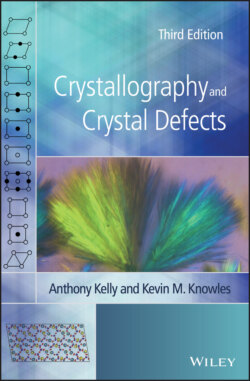Читать книгу Crystallography and Crystal Defects - Anthony Kelly - Страница 17
1.4.1 Translational Symmetry
ОглавлениеThis describes the fact that similar atoms in identical surroundings are repeated at different points within the crystal. Any one of these points can be brought into coincidence with another by an operation of translational symmetry. For instance, in Figure 1.1a the carbon atoms at O, Y, N and Q occupy completely similar positions. We use the idea of the lattice to describe this symmetry. The lattice is a set of points each with an identical environment which can be found by inspection of the crystal structure, as in the example in Figure 1.1b. We can define the arrangement of lattice points in a three‐dimensional crystal by observing that the vector r joining any two lattice points (or the operation of translational symmetry bringing one lattice point into coincidence with another) can always be written as:
(1.21)
where u, v, w are positive or negative integers, or equal to zero. Inspection of Figure 1.11 shows that to use this description we must be careful to choose a, b and c so as to include all lattice points. We do this by, say, making a the shortest vector between lattice points in the lattice, or one of several shortest ones. We then choose b as the shortest not parallel to a and c as the shortest not coplanar with a and b. Thus a, b and c define a primitive unit cell of the lattice in the same sense as in Section 1.1. Only one lattice point is included within the volume a · [b × c],7 which is the volume of the primitive unit cell; under these circumstances a, b and c are called the lattice translation vectors.
Figure 1.11 Translation symmetry in a crystal
